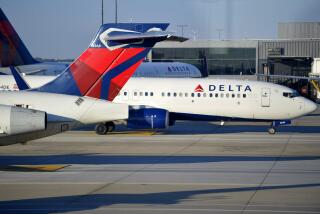Making Sure Teen Tours Aren’t Full of Sky High Jinks
- Share via
And United Airlines thinks its skies are friendly. Federal Aviation Administration officials are investigating reports that a recent charter flight of unchaperoned high schoolers devolved into a sort of “Animal House” aloft, including a wet T-shirt contest that may have been encouraged by a flight attendant and cockpit crew members.
The trip, organized by Phoenix-based tour operator Cerkvenik-Anderson Travel, included about 150 just-graduated high school seniors from the Pacific Northwest. It began with a June 11 flight from Portland, Ore., to Mazatlan, Mexico, with a return flight a week later. An Associated Press story included witness accounts describing five wet T-shirt contest competitors entering the cockpit.
Some witnesses said the week’s activities included fake orgasm contests, booze cruises and coed swimsuit-switching races. One student rolled videotape on part of the raucous flight south.
Cerkvenik-Anderson Travel did not return phone calls for this column. At Falcon Air Express, the air charter company hired by the tour operator, officials acknowledged that “a contest among the passengers was conducted and subsequently terminated.” But Falcon Executive Vice President Jose Lazaga added that from now on, “we are going to request on every [student charter] flight [there be] an adult tour conductor . . . I’m sure that we will never do another flight with just students.”
Clearly, this case raises the question of how families can best choose a travel program for their teenager.
The usual advice for anyone checking out a tour operator is to check its membership in trade groups, most notably the American Society of Travel Agents or the U.S. Tour Operators Assn., which require members to meet various professional standards in finances and operations. It is wise to ask about such affiliations, but there are no guarantees. Any parents investigating Cerkvenik-Anderson Travel, promoter of the controversial Mazatlan trip, would have found that the company has been an ASTA member in good standing since 1994.
The best single source for checking out an educational tour company, many experts say, is the Council on Standards for International Educational Travel (212 S. Henry St., Alexandria, VA 22314; telephone [703] 739-9050). Every year, the organization assesses student travel and exchange programs, rejecting those that don’t meet its detailed standards, and publishes a list of groups it endorses.
The 1998-99 list includes 64 organizations that arrange travel for students in grades nine to 12. The list is formally known as the CSIET Advisory List of International Educational Travel and Exchange Programs and costs $15 per copy, although one free copy goes to every public and private U.S. high school, about 58,000 campuses last year.
The vast majority of the approved organizations are nonprofit groups, says Vanessa Relli-Moreau, the CSIET’s membership director, and the duration of programs varies from one week to a 10-month academic year abroad. “Every day I hear of a new organization” selling trips to students, Relli-Moreau says. And they’re chasing a large market: The CSIET-approved programs together sent 25,877 teens to 119 countries last year. Other industry veterans have estimated that even more students sign on for nonacademic trips celebrating spring break or high school graduation. In screening companies for this year’s directory, the CSIET added three new groups and rejected about 10 organizations, Relli-Moreau said.
Here are some questions she suggests parents ask:
Can parents speak to a teen who’s gone abroad and ask what he or she thought of the program? What is the organization’s history? What kind of expertise does the staff bring? Can the group supply references from former host families (if home stays are involved) or schools? How do they handle emergencies? Insurance?
Every family needs to evaluate programs for itself and there are two organizations approved by the CSIET:
* The American Field Service, tel. (800) 237-4636, based in New York, has been organizing student exchanges for about 50 years. Christine Vogel, AFS vice president for marketing and communications, estimates that 10,000 students worldwide join in AFS exchanges each year, including about 1,700 outbound U.S. students. Programs range from four weeks in summer to a 10-month academic year. Most trips involve home stays with families that volunteer to serve as hosts.
* The Council on International Educational Exchange, tel. (800) 669-0469, a nonprofit group that also operates the Council Travel offices near many college campuses, has run high school travel programs for 26 years. Program manager Darren Bosch says the CIEE typically sends groups of six to 20 students, with a teacher, on a three-week trip abroad during a U.S. school holiday. Students usually stay in volunteer families’ homes abroad. Partner countries include Germany, France, Spain, Costa Rica, Mexico, Japan, Italy, and Bosch estimates that about 1,100 American students traveled abroad through the program last year.
Reynolds travels anonymously at the newspaper’s expense, accepting no special discounts or subsidized trips. He welcomes comments and suggestions, but cannot respond individually to letters and calls. Write Travel Insider, Los Angeles Times, Times Mirror Square, Los Angeles 90053 or e-mail chris.reynolds@latimes.com.
More to Read
Sign up for The Wild
We’ll help you find the best places to hike, bike and run, as well as the perfect silent spots for meditation and yoga.
You may occasionally receive promotional content from the Los Angeles Times.







